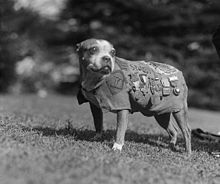Stubby (dog)
Sergeant Stubby (born 1916 or 1917; died March 16, 1926) was the highest honored dog of the First World War and the only one who was raised to the rank of " Sergeant " (non-commissioned officer).
youth
Stubby was a Bull Terrier mix (presumably from Boxer or Boston Terrier ) who, a few weeks old, walked to the campus of Yale University in 1917 as a stray John Robert Conroy. When he had to go to France as a soldier, he smuggled the dog on board the USS Minnesota .
military service
Stubby served 18 months in the 102nd Infantry, 26th (Yankee) Division in the trenches of World War I, taking part in 4 offensives and 17 battles. He has been awarded many military medals. He wore this on a collar that the women of Château-Thierry had made for him. Stubby learned to warn his unit of poison gas attacks and to locate wounded soldiers in the no man's land of the battlefield. He was able to perceive the approach of an artillery shell earlier than his unit and to make a sound accordingly. He even single-handedly hired a German spy. Stubby was wounded a number of times and learned a kind of salute.
Late years
From 1922 to 1923, Stubby attended Georgetown University with John Robert Conroy and became the athletics team's mascot. He died on March 16, 1926 in the arms of its owner. Stubby was later groomed and is now on display with carrier pigeon Cher Ami in the Smithsonian's National Museum of American History .
Orders and awards
At the end of the war, Stubby met President Woodrow Wilson and shook his hand. He became quite famous and marched in many parades. In 1921 he received the "special gold medal" from General John Pershing for the services rendered to his fatherland.
literature
- Smithsonian Institution , " The Price of Freedom: Americans at War - Stubby "
- Connecticut Military Department, " Stubby the Military Dog "
Web links
Individual evidence
- ↑ Ann Bausum: Sergeant Stubby: How a Stray Dog and His Best Friend Helped Win World War I and Stole the Heart of a Nation . National Geographic , Washington, DC 2014, ISBN 978-1-4262-1310-6 , pp. 220 (English).
